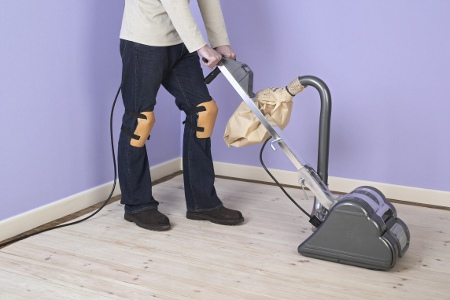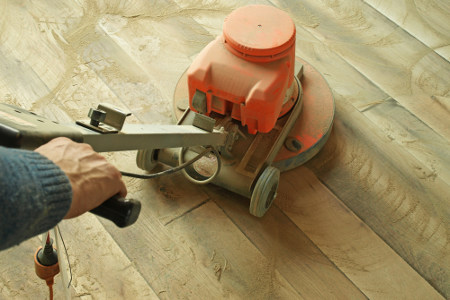Did You Know?
Improperly sanding a hardwood floor can pose a fire risk. Moreover, bags containing dust from the sanding operation should be disposed immediately, as they can spontaneously catch fire.A sander is an electric device that helps smoothen a rough surface. There are several types of sanders; like belt, drum, orbital, random orbit sanders, and so on. But the common property among all is that they operate by using an abrasive surface that rubs on the floor. The difference between various sanding devices is in the method by which the abrasive surface contacts the floor.
Sanding is used to remove earlier coats of finish, or to remove bumps and depressions from the floor, before a new coat is applied so that it adheres well. This process may also be performed on a newly-laid hardwood floor, before the initial coat of stain is applied.
Two of the most commonly used floor sanders are drum and orbital sanders, and they are routinely confused with each other. As its name suggests, the drum sander operates using a high-speed rotating drum, while the orbital sander uses an oscillating pad which moves in an 'orbital' fashion. While the drum sander is a piece of heavy-duty equipment, the orbital sander is mostly used for light finishing tasks. A more detailed comparison between drum and orbital sanders follows.

Drum Vs. Orbital Sander Purpose Working Pros Cons When to Use Desirable Features
Drum Sander

Orbital Sander
Purpose
Drum SanderA drum sander is used to remove thick layers of finish from a wooden floor, and can even re-level an uneven floor which has swellings or depressions.
Orbital SanderAn orbital sander is used for dirt removal or light sanding, such as removing the top coat of finish, or a layer of putty. It can be used where sanding has to be done across the wood grain, and in narrow spaces like hallways, entryways, edges, and corners. Orbital sanders are also used for screening and blending of the floor before the first coat of finish is applied.
Back to Top
Working
Drum SanderThe drum sander consists of an 8"-wide rotating drum covered with a 20"-long sandpaper. Using either motor power or compressed air, the drum is spun rapidly at a speed of 1,800 rpm in one direction, causing only a small area of the drum to rub on the floor. This provides a lot of abrasive power to the sander, which operates using an aggressive cutting action, rather than a grinding one. The performance of the drum sander relies on the drum speed, grit of the sandpaper, and the speed at which the user moves it across the floor.
Orbital SanderThe orbital sander consists of a 12" × 18" sanding pad, which, rather than spinning, oscillates to and fro in an orbit. It may perform as many as 3,450 vibrations a minute. A large area of the sandpaper is in contact with the floor, which results in less force being applied, and repetitive scratching does not occur. This sander works using a grinding action, rather than a cutting one. It relies on the weight of the machine to deliver pressure, which is about 2 pounds per square inch.
Back to Top
Pros
Drum Sander▲ It is well-suited for removal of stubborn layers of finish, as well as major floor re-leveling.
▲ It has a rapid rate of operation, and is about 10 times faster than an orbital sander.
▲ Performance-wise, a drum sander is the best.
Orbital Sander▲ It can be used by an amateur, as it does not damage the floor in any way.
▲ Though it is heavy to lift, it effortlessly glides over the floor during use, making physical exertion unnecessary.
▲ It is cheaper by at least a couple hundred dollars when compared to the drum sander.
▲ It can be used in narrow spaces like hallways, pantry or entryways, where sanding is to be done against the wood grain.
▲ Its rectangular pad makes accessing corners easier.
Back to Top
Cons
Drum Sander▼ Due to its high abrasive power, the drum sander can leave depressions, called 'drum stops', in the floor, if not carefully used.
▼ It is inappropriate for sanding against the wood grain, especially at an angle of 90o, and will leave sanding scratches in such a case.
▼ If used by amateurs, it can cause irreparable damage. Hence, most DIY floor sanders call professionals for refinishing.
▼ It cannot be used on edges, entryways, hallways, and in other narrow spaces.
▼ It is much costlier than an orbital sander. Since it can't sand in narrow gaps, an edger sander must necessarily be purchased or rented, further increasing the cost involved.
Orbital Sander▼ Its biggest drawback is the slow rate of operation. In several cases, an orbital sander will perform a task in a couple of hours, which the drum sander completes in a matter of minutes.
▼ Since it takes more time, more dust is generated during the process.
▼ It is suited for light sanding, and may not remove tough coats of finish, or it may take a lot more time to do so. It also cannot correct any imperfections on a wooden floor.
▼ It may leave circular scratch marks on the floor, in rare cases.
Back to Top
When to Use
Drum Sander◆ A drum sander can be used if the floor has not been sanded repeatedly in the past, as each operation reduces the thickness of the floor. Due to its high power, it can easily cut through the finish, and into the wood if it is thin.
◆ The condition of the floor is the main criterion when choosing a sander. If the floor is warped, needs re-leveling, has heavy damage like gouging and scarring, or requires heavy varnish removal, then a drum sander is the best choice.
◆ If the operator is experienced, he can choose this type due to its high performance.
◆ A minor factor is the strength required to load and unload the device onto a vehicle. Though an employee from the rental yard or store may offer help while loading and unloading the sander, on reaching home one may require help if he/she lacks the required strength.
Orbital Sander◆ If the operator is an amateur, then the orbital sander is a safer alternative due to its gentle operation.
◆ If one can't afford the rental price of a drum sander, then the orbital sander is preferable.
◆ If the floor is in good condition and requires light finishing without any heavy-duty equipment, then this type is ideal.
◆ If one has to sand in narrow spaces, like entryways or hallways, which the drum sander can't access or creates sanding marks, then go in for an orbital sander.
Back to Top
Desirable Features to Look for when Renting/Buying
Drum Sander…Ease of replacing sandpaper.
…Ability of lowering the drum towards the floor while placing the device in a three-foot stance.
…Easy disassembling of device parts for transportation.
…Facility of connecting the unit to a tank vacuum to collect dust.
Orbital Sander…A reputed model with proven performance.
…Ability to use generic sandpaper.
…Facility to connect the unit to a tank vacuum for dust collection.
While a drum sander is a favorite among professionals owing to its excellent performance, the kind of sander suitable for you depends on various factors like the condition of your floor, budget, nature of work required, and your skills, to name a few. So keeping all the above points in mind, make an informed choice and get the job done to perfection.





